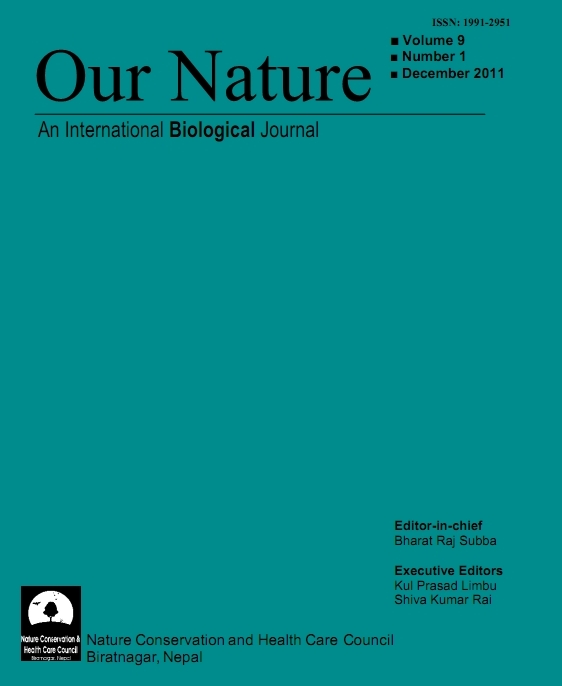Potential and Economic Viability of Freshwater Prawn Macrobrachium rosenbergii (de Man, 1879) Polyculture with Indian Major Carps in Northwestern Bangladesh
DOI:
https://doi.org/10.3126/on.v9i1.5735Keywords:
Prawn, growth, Macrobrachium rosenbergii, production, economics, carp polycultureAbstract
This study was conducted to assess the aquaculture potential of the freshwater prawn Macrobrachium rosenbergii (de Man, 1879) with the Indian major carps (Catla, Catla catla; Rui, Labeo rohita and Mrigal, Cirrhinus mrigala) and silver carp, Hypophthalmichthys molitrix in northwestern Bangladesh. Further, the effect of the culture system on overall production and economic feasibility was evaluated. A 3×2 (treatment×replicate) experimental setup was conducted using six earthen ponds measuring 100 m2 each for a culture period of six months from September, 2007 to February, 2008. The treatments were as follows: T1 was stocked with only carps (catla, rohu, mrigal and silver) at the 3000 (catla), 2000 (ruhu), 3000 (mrigal) and 2000 (silver) ha-1; T2 and T3 were stocked with catla and silver carp were 3000 and 2000 ha-1, respectively; and additionally M. rosenbergii (juvenile) was stocked at 15000 and 20000 ha-1 in T2 and T3, respectively. All the ponds were subjected to the same fertilization treatment. Fish were fed twice per day at a rate of 5-12% of the prawn and fish body weight. The net weight gain of catla and silver carp were 69.08±11.63 and 108.67±15.00 g in T1, 61.76±12.58 and 98.80±17.05 g in T2, while 58.11±12.51 and 93.09±14.84 g in T3, respectively. The mean individual weight of harvested prawn was significantly higher in T2 (14.61±02.06 g) than T3 (14.04±01.83 g) (P<0.05). Also the survival rate of prawn was higher in T2 (74.15%) than T3 (69.25%) (P<0.05). The net production of prawn was higher in T3 (1141.28±46.35 kg ha-1) than T2 (964.54±25.53 kg ha-1), but the specific growth rate was significantly higher in T2 (2.07%) than T3 (1.99%) (P<0.05). Higher profit was obtained in T3 (35682.18 Tk ha-1) than T1 (8537.53 Tk ha-1) and T2 (30801.56 Tk ha-1); however, cost-benefit ratio (CBR) was significantly higher in T2 (3.19) where stocking densities of prawn was 15000 ha-1 than T1 (2.92) and T3 (2.47). The results of this experiment indicate that the polyculture of the freshwater prawn with the Indian major and Chinese carp present a more profitable venture which is more economically feasible than the monoculture of the freshwater prawn.
Downloads
Downloads
How to Cite
Issue
Section
License
This license enables reusers to distribute, remix, adapt, and build upon the material in any medium or format for noncommercial purposes only, and only so long as attribution is given to the creator.




